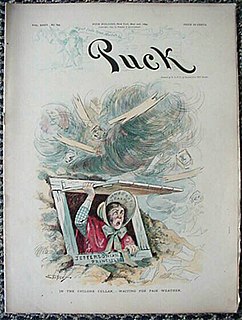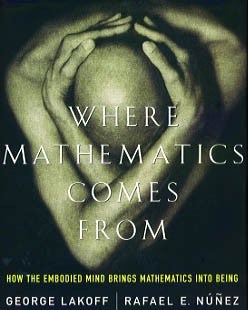
A metaphor is a figure of speech that, for rhetorical effect, directly refers to one thing by mentioning another. It may provide clarity or identify hidden similarities between two different ideas. Metaphors are often compared with other types of figurative language, such as antithesis, hyperbole, metonymy and simile. One of the most commonly cited examples of a metaphor in English literature comes from the "All the world's a stage" monologue from As You Like It:
The hypothesis of linguistic relativity, also known as the Sapir–Whorf hypothesis, the Whorf hypothesis, or Whorfianism, is a principle suggesting that the structure of a language affects its speakers' worldview or cognition, and thus people's perceptions are relative to their spoken language.

Where Mathematics Comes From: How the Embodied Mind Brings Mathematics into Being is a book by George Lakoff, a cognitive linguist, and Rafael E. Núñez, a psychologist. Published in 2000, WMCF seeks to found a cognitive science of mathematics, a theory of embodied mathematics based on conceptual metaphor.

George Philip Lakoff is an American cognitive linguist and philosopher, best known for his thesis that people's lives are significantly influenced by the conceptual metaphors they use to explain complex phenomena.

Moral Politics: How Liberals and Conservatives Think is a 1996 book by cognitive linguist George Lakoff. It argues that conservatives and liberals hold two different conceptual models of morality. Conservatives have a strict father model in which people are made good through self-discipline and hard work, everyone is taken care of by taking care of themselves. Liberals have a nurturant parent model in which everyone is taken care of by helping each other.
In cognitive linguistics, conceptual metaphor, or cognitive metaphor, refers to the understanding of one idea, or conceptual domain, in terms of another. An example of this is the understanding of quantity in terms of directionality or the understanding of time in terms of money.
Cognitive linguistics is an interdisciplinary branch of linguistics, combining knowledge and research from cognitive science, cognitive psychology, neuropsychology and linguistics. Models and theoretical accounts of cognitive linguistics are considered as psychologically real, and research in cognitive linguistics aims to help understand cognition in general and is seen as a road into the human mind.

Metonymy is a figure of speech in which a thing or concept is referred to by the name of something closely associated with that thing or concept.

An image schema is a recurring structure within our cognitive processes which establishes patterns of understanding and reasoning. As an understudy to embodied cognition, image schemas are formed from our bodily interactions, from linguistic experience, and from historical context. The term is introduced in Mark Johnson's book The Body in the Mind; in case study 2 of George Lakoff's Women, Fire and Dangerous Things: and further explained by Todd Oakley in The Oxford handbook of cognitive linguistics; by Rudolf Arnheim in Visual Thinking; by the collection From Perception to Meaning: Image Schemas in Cognitive Linguistics edited by Beate Hampe and Joseph E. Grady.
In cognitive linguistics, conceptual blending, also called conceptual integration or view application, is a theory of cognition developed by Gilles Fauconnier and Mark Turner. According to this theory, elements and vital relations from diverse scenarios are "blended" in a subconscious process, which is assumed to be ubiquitous to everyday thought and language. Much like memetics, it is an attempt to create a unitary account of the cultural transmission of ideas.
Mark L. Johnson is Knight Professor of Liberal Arts and Sciences in the Department of Philosophy at the University of Oregon. He is known for contributions to embodied philosophy, cognitive science and cognitive linguistics, some of which he has coauthored with George Lakoff such as Metaphors We Live By. However, he has also published on philosophical topics such as John Dewey, Immanuel Kant and ethics.
Construction grammar is a family of theories within the field of cognitive linguistics which posit that constructions, or learned pairings of linguistic patterns with meanings, are the fundamental building blocks of human language. Constructions include words, morphemes, fixed expressions and idioms, and abstract grammatical rules such as the passive voice or the ditransitive. Any linguistic pattern is considered to be a construction as long as some aspect of its form or its meaning cannot be predicted from its component parts, or from other constructions that are recognized to exist. In construction grammar, every utterance is understood to be a combination of multiple different constructions, which together specify its precise meaning and form.
Cognitive semantics is part of the cognitive linguistics movement. Semantics is the study of linguistic meaning. Cognitive semantics holds that language is part of a more general human cognitive ability, and can therefore only describe the world as people conceive of it. It is implicit that different linguistic communities conceive of simple things and processes in the world differently, not necessarily some difference between a person's conceptual world and the real world.
Cognitive poetics is a school of literary criticism that applies the principles of cognitive science, particularly cognitive psychology, to the interpretation of literary texts. It has ties to reader-response criticism, and also has a grounding in modern principles of cognitive linguistics.
Cognitive rhetoric refers to an approach to rhetoric, composition, and pedagogy as well as a method for language and literary studies drawing from, or contributing to, cognitive science.
Gerald Zaltman is the Joseph C. Wilson Professor Emeritus at Harvard Business School and the author and editor of 20 books, most recently How Customers Think (2003) and Marketing Metaphoria (2008). In 1997 he founded the market research consulting firm Olson Zaltman Associates in partnership with Jerry C. Olson, Professor of Marketing Emeritus, Smeal College of Business at Penn State. Zaltman patented, the Zaltman Metaphor Elicitation Technique, a method used to delve into the unconscious thinking that drives behavior.
Experientialism is a philosophical view developed by George Lakoff and Mark Johnson. It was first formulated in Metaphors We Live By. In Women, Fire and Dangerous Things, Lakoff expands on the foundations of experientialism with research into the nature of categories.
In cognitive linguistics, the invariance principle is a simple attempt to explain similarities and differences between how an idea is understood in "ordinary" usage, and how it is understood when used as a conceptual metaphor.
Embodied cognition is the theory that many features of cognition, whether human or otherwise, are shaped by aspects of the entire body of the organism. The features of cognition include high level mental constructs and performance on various cognitive tasks. The aspects of the body include the motor system, the perceptual system, bodily interactions with the environment (situatedness), and the assumptions about the world that are built into the structure of the organism.
Raymond W. Gibbs Jr. was a Psychology professor and researcher at the University of California, Santa Cruz. His research interests are in the fields of experimental psycholinguistics and cognitive science. His work concerns a range of theoretical issues, ranging from questions about the role of embodied experience in thought and language, to looking at people's use and understanding of figurative language. Raymond Gibbs's research is especially focused on bodily experience and linguistic meaning. Much of his research is motivated by theories of meaning in philosophy, linguistics, and comparative literature.






